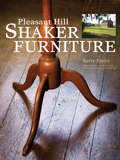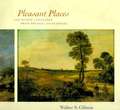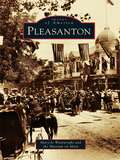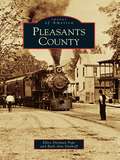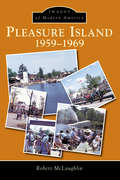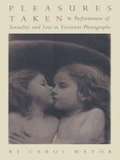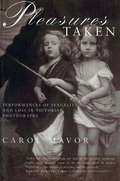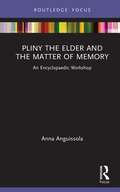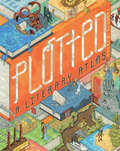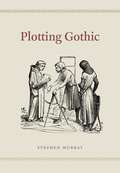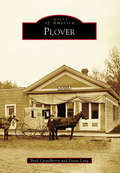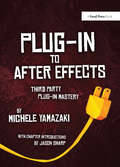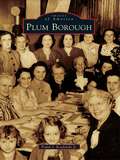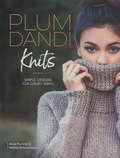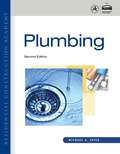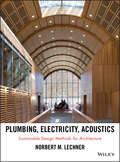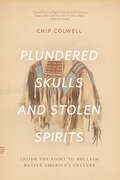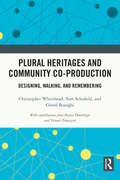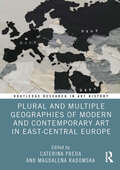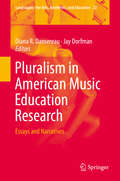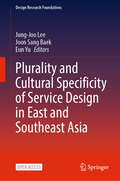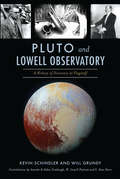- Table View
- List View
Pleasant Hill Shaker Furniture: 10 Projects You Can Build
by Kerry PierceAnn Lee, founder of the Shaker movement, offered this guidance to her followers, "Hands to work and hearts to God". The furniture of the Pleasant Hill community shows her philosophy brought to life in every piece.With its beauty and simplicity, Shaker furniture has inspired generations of furniture makers like no other style in the world. This book details the construction and design of some rare and never before seen Shaker furniture created in the village of Pleasant Hill, Kentucky. Painstakingly illustrated with drawings and photos of the furniture, this book reveals the joinery and design secrets that make Shaker furniture timeless. You'll find full-scale details of the joinery and special details about the furniture as well as a charming history of the village of Pleasant Hill.
Pleasant Places: The Rustic Landscape from Bruegel to Ruisdael
by Walter S. GibsonGibson focuses on Haarlem between 1600 and 1635, in his interpretation of Dutch landscapes and emphasizes prints, the medium in which the rustic view was first made available to the general art-buying public. Gibson begins by looking at the origins of the rustic landscape in the sixteenth-century Flanders and its later reformation by Dutch artists, a legacy very much alive today.
Pleasanton
by Museum On Main Mary-Jo WainwrightThe city of Pleasanton, located in the beautiful Amador-Livermore valley, was formed in 1867 when immigrants John Kottinger and Joshua Neal used land from their Californio wives' dowries and laid out a town. Kottinger named the city after Civil War general Alfred Pleasonton, but a postal clerical error changed the spelling to "Pleasanton" and the name stuck. The men secured Pleasanton's future by offering land to the Western Pacific Railroad for a railroad station and landing. Planning for future growth thus became a legacy that is still embraced by this modern city of 70,000 people. Today families and tourists are attracted to Pleasanton's historic downtown, where 19thcentury buildings still stand and people stroll among its many shops and restaurants.
Pleasants County
by Ellen Pope Ruth Ann DayhoffFormed from portions of Wood, Tyler, and Ritchie Counties, Pleasants County was founded in 1851 and was named after Gov. James Pleasants Jr. of Virginia. Residents of Pleasants County fondly recall many of the buildings that no longer exist today, such as the button factory, blacksmith shop, marble factory, and the Quaker State Oil Refinery, all of which are preserved in the photographs that are showcased throughout Images of America: Pleasants County. Taking a step back in time, these photographs illustrate how the town and county looked more than 100 years ago, exploring a variety of the county's activities and historic scenes and offering a colorful insight into the past as well as the present.
Please Don't Grab My P#$$Y: A Rhyming Presidential Guide
by Laura Collins Julia Young Matt HarkinsThrough campy pop culture rhymes and beautiful oil paintings, the narrator of our book guides you though a list of things you CAN grab while offering more poetic ways to refer to a woman’s genitalia than the word “pussy” that Trump so vulgarly used. As the narrator goes on, she lets you know more about her relatives (a reclusive aunt with a lazy eye) and her interests (Justin Bieber’s Instagram) while never losing sight of her mission to make the President as uncomfortable as possible. We think that the President, not to mention men in Hollywood, Wall Street, the news media and beyond, can benefit from reading our book. No matter who you are, or how dumb you are, you’ll be able to understand this book’s simple message: Hands off my pussy!
Pleasure Island: 1959-1969
by Robert MclaughlinPleasure Island opened on June 22, 1959, in Wakefield, Massachusetts. Designed by Marco Engineering of Los Angeles, it was the second of three innovative theme parks built across America to mimic Disneyland. Pleasure Island was conceived by William Hawkes, president of Child Life magazine, and with support from Boston's Cabot, Cabot & Forbes and local and national investors, the vision of the park was brought to life. Just by passing through a turnstile, children and the young at heart could leave the present and enter into a world of the past. Clipper Cove was a replica of an old New England fishing village, and Goldpan Gulch re-created the Old West. With state-of-the-art attractions and national and local live entertainment, Pleasure Island became one of the top-grossing parks in the nation. Known as the "Disneyland of the East," the park was enjoyed for 11 seasons, until its closing in 1969.
Pleasures Taken: Performances of Sexuality and Loss in Victorian Photographs
by Carol MavorAn intimate look into three Victorian photo-settings, Pleasures Taken considers questions of loss and sexuality as they are raised by some of the most compelling and often misrepresented photographs of the era: Lewis Carroll's photographs of young girls; Julia Margaret Cameron's photographs of Madonnas; and the photographs of Hannah Cullwick, a "maid of all work," who had herself pictured in a range of masquerades, from a blackened chimney sweep to a bare-chested Magdalene. Reading these settings performatively, Carol Mavor shifts the focus toward the subjectivity of these girls and women, and toward herself as a writer.Mavor's original approach to these photographs emphatically sees sexuality where it has been previously rendered invisible. She insists that the sexuality of the girls in Carroll's pictures is not only present, but deserves recognition, respect, and scrutiny. Similarly, she sees in Cameron's photographs of sensual Madonnas surprising visions of motherhood that outstrip both Victorian and contemporary understandings of the maternal as untouchable and inviolate, without sexuality. Finally she shows how Hannah Cullwick, posing in various masquerades for her secret paramour, emerges as a subject with desires rather than simply a victim of her upper-class partner. Even when confronting the darker areas of these photographs, Mavor perseveres in her insistence on the pleasures taken--by the viewer, the photographer, and often by the model herself--in the act of imagining these sexualities. Inspired by Roland Barthes, and drawing on other theorists such as Julia Kristeva and Luce Irigaray, Mavor creates a text that is at once interdisciplinary, personal, and profoundly pleasurable.
Pleasures Taken: Performances of Sexuality and Loss in Victorian Photographs
by Carol MavorLewis Carroll's photographs of young girls, Julia Margaret Cameron's photographs of Madonnas and the photographs of Hannah Cullwick, "maid of all work", pictured in masquerade - Carol Mavor addresses the erotic possibilities of these images, exploring not ony the sexualities of the girls, maids and Madonnas, but the pleasures taken - by the viewer, the photographer, the model - in imagining these sexualities.
Pliny the Elder and the Emergence of Renaissance Architecture
by Peter Fane-SaundersThe Naturalis historia by Pliny the Elder provided Renaissance scholars, artists and architects with details of ancient architectural practice and long-lost architectural wonders - material that was often unavailable elsewhere in classical literature. Pliny's descriptions frequently included the dimensions of these buildings, as well as details of their unusual construction materials and ornament. This book describes, for the first time, how the passages were interpreted from around 1430 to 1580, that is, from Alberti to Palladio. Chapters are arranged chronologically within three interrelated sections - antiquarianism; architectural writings; drawings and built monuments - thereby making it possible for the reader to follow the changing attitudes to Pliny over the period. The resulting study establishes the Naturalis historia as the single most important literary source after Vitruvius's De architectura.
Pliny the Elder and the Matter of Memory: An Encyclopaedic Workshop (Young Feltrinelli Prize in the Moral Sciences)
by Anna AnguissolaThe Roman official and intellectual Pliny the Elder’s Natural History constitutes our primary source on the figural arts in Classical antiquity. Since the Middle Ages, Pliny’s encyclopaedia has enraptured the imaginations of its readers with anecdotes and narratives about the lives and accomplishments of the great artists of the Greek past. This book explores the ways in which materials and artistic processes are constructed in Natural History. In doing so, this work reflects current developments in the study of Graeco-Roman art, where the scientific analysis of sculptural stones, pigments, and metal alloys, as well as a more detailed understanding of technologies and workshop practices, has imposed radical changes in the methods and theoretical models used to approach ancient artefacts. The argument considers the role of materials in discourses on Nature, as well as their semantics and the language used to account for artistic creation. Discussion of artistic techniques addresses the discovery of resources and technologies, and the discursive implications of creation and viewing. By focusing on particular passages and exemplary case studies, this book explores the ideological, moral, and intellectual preoccupations that guide Pliny’s construction of materialities and human ingenuity in a period characterised by a rapidly-evolving economic landscape. The material and performative aspects of artistic, manual creation provided this early encyclopaedist with the fundaments for constructing and explaining his view of Rome’s imperial mission and, more specifically, of his own strategies as a collector and recorder of ‘all’ the memorable facts of Nature. This book will be of significant interest to scholars of classical archaeology, Greek and Latin literature, social and economic history, and reception studies.
Plotted: A Literary Atlas
by Daniel Harmon Andrew DegraffThis incredibly wide-ranging collection of maps--all inspired by literary classics--offers readers a new way of looking at their favorite fictional worlds. <P><P>Andrew DeGraff's stunningly detailed artwork takes readers deep into the landscapes from The Odyssey, Hamlet, Pride and Prejudice, Invisible Man, Lord of the Flies, A Wrinkle in Time, Watership Down, The Handmaid's Tale, and more. Sure to reignite a love for old favorites and spark fresh interest in more recent works as well, Plotted provides a unique new way of appreciating the lands of the human imagination.
Plotting Gothic
by Stephen MurrayA historian of medieval art and architecture with a rich appreciation of literary studies, Stephen Murray brings all those fields to bear on a new approach to understanding the great Gothic churches of the twelfth and thirteenth centuries. Plotting Gothic positions the rhetoric of the Gothic as a series of three interlocking plots: a spatial plot tied to the material construction of the churches, a social plot stemming from the collaborative efforts that made Gothic output possible, and a rhetorical plot involving narratives that treat the churches as objects of desire. Drawing on the testimony of three witnesses involved in church building--Abbot Suger of Saint-Denis, Gervase of Canterbury, and the image maker Villard de Honnecourt--and a range of secondary sources, Murray traces common patterns in the way medieval buildings were represented in words and images. Our witnesses provide vital information about the way the great churches of Gothic were built and the complexity of their meanings. Taking a fresh approach to Gothic architecture, Plotting Gothic offers an invigorating new way to understand some of the most lasting achievements of the medieval era.
Plover (Images of America)
by Diane Lang Brad CasselberryNestled on the Yellow Banks of the Wisconsin River, Plover was originally used by Native Americans for portaging between the Wisconsin and Wolf Rivers. After being established as the Portage County seat in 1844, the area grew rapidly. Soon, mills sprang up, farmers worked the land, businesses flourished, and lodging could not be built fast enough to keep up with the demand. By 1857, Plover boasted 500 residents and 112 buildings, with 40 more under construction. In 1868, the county seat was moved out of Plover, and by the mid-1880s, Plover had begun to decline. Despite this, and the fact that the village has been dissolved twice, incorporated three separate times, and gone by four different names, Plover has proved resilient. Since being reincorporated in 1971, Plover has thrived and grown at an impressive rate. Today, the main businesses are part of the industrial, agricultural, and retail sectors.
Plug-in to After Effects: The Essential Guide to the 3rd Party Plug-ins
by Michele YamazakiTake your After Effects projects to the next level by mastering its third-party plug-ins. Whether it's keying and compositing, adding particles of swirling smoke to a composition, or importing XML files from Final Cut Pro, third-party plug-ins can greatly enhance your After Effects capabilities. From sexy effects and graphics enhancements to workflow automation and file conversion, it's all covered in this lavishly illustrated, full-color book.Coverage of hundreds of essential third-party plug-ins is provided, showing you when, why, and how to use each plug-in. Plug-ins for color, style, effects, distortions, warps, transitions, lens flares, text and graphical elements, and more are all covered in depth.
Plum Borough (Images of America)
by Frank J. Kordalski Jr.Plum Township, which later reorganized as Plum Borough, was founded on December 18, 1788, and westward pioneers soon chose to settle in the region. William McJunkin, an Irish emigrant and one of the earliest settlers, came to Plum Borough and in 1790 was granted a tract of land he came to call "Greenfield." In the 19th century, Plum Borough was an agricultural gold mine for the brave settlers who wished to emigrate from their East Coast homesteads. During the 20th century, Plum Borough emerged from being an agricultural suburb of the Steel City to become a vibrant residential community with a wondrously bright future.
Plum Dandi Knits: Simple Designs for Luxury Yarns
by Alicia Plummer Melissa SchaschwaryPolished knits. Plush yarns. Perfect match. Sometimes nature's most beautiful details are the perfect inspiration for creating simple yet luxurious knits. In Plum Dandi Knits, Alicia Plummer and Melissa Schaschwary--designers, friends, and leaders of the much-love Plum Dandi group on Ravelry--bring you 23 projects that reflect and react to the natural world with a sumptuous twist of plush fibers, feminine accents, and stylish comfort. Lace that mimics soft forest foliage or the numerous tassels of a pine tree. Textured patterns that call to mind a babbling brook or waterfall. Thick wool shawls and sweaters knit in anticipation of blustery cold days ahead. The uncomplicated pieces in this collection, knit in soft, luxe yarns, are soothing complements to slowing down and settling into peaceful moments. Wherever you seek stillness and calm, Plum Dandi Knits will help take you there.
Plumbing
by Michael A. JoyceRESIDENTIAL CONSTRUCTION ACADEMY: PLUMBING, 2E is the ideal book to create a direct link between readers' education/training program and the residential construction industry. The result of a strategic partnership between the National Association of Home Builder's (NAHB) Home Builders Institute and Delmar, Cengage Learning, the Residential Construction Academy Series is the perfect way to learn essential workplace skills for readers new to the building trades. Written in partnership with the Home Builders Institute, and endorsed by NAHB, RESIDENTIAL CONSTRUCTION ACADEMY: PLUMBING, 2E provides a step-by-step approach to residential plumbing installations based on national skill standards. Focusing on "Green" advancement in the plumbing trades, this book thoroughly explains the process of installing residential plumbing systems by exploring topics such as tools of the trade and proper safety measures and by offering various tips to increase readers' on-the-job productivity. Logically organized to build a foundation of knowledge, this book progresses from the installation of common fixtures to troubleshooting techniques that will aid readers. An emphasis on creative layout and the importance of understanding code variations will foster readers' understanding of plumbing system installation that is based on typical situations as well as unique jobsite conditions.
Plumbing, Electricity, Acoustics
by Norbert LechnerDiscover sustainable methods for designing crucial building systems for architects. This indispensable companion to Norbert Lechner's landmark volume Heating, Cooling, Lighting: Sustainable Design Methods for Architects, Third Edition completes the author's mission to cover all topics in the field of sustainable environmental control. It provides knowledge appropriate for the level of complexity needed at the schematic design stage and presents the most up-to-date information available in a concise, logical, accessible manner and arrangement. Although sustainability deals with many issues, those concerning energy and efficiency are the most critical, making an additional goal of this book one of providing architects with the skills and knowledge needed to create buildings that use electricity and water efficiently. Guidelines and rules-of-thumb are provided to help designers make their buildings use less energy, less water, and less of everything else to achieve their primary objectives. In addition, this book: Addresses ways to reduce electricity usage through more efficient lighting systems and appliances and by incorporating automatic switches and control systems that turn off systems not in use. Covers the design of well-planned effluent treatment systems that protect against potential health hazards while also becoming a valuable source of reclaimed water and fertilize. r Provides coverage of fire protection and conveyance systems, including very efficient types of elevators and escalators and designs that encourage the use of stairs or ramps. Complete with case studies that illustrate how these systems are incorporated into large-project plans, Plumbing, Electricity, Acoustics is an indispensable resource for any architect involved in a sustainable design project.
Plundered Skulls and Stolen Spirits: Inside the Fight to Reclaim Native America's Culture
by Chip ColwellWho owns the past and the objects that physically connect us to history? And who has the right to decide this ownership, particularly when the objects are sacred or, in the case of skeletal remains, human? Is it the museums that care for the objects or the communities whose ancestors made them? These questions are at the heart of Plundered Skulls and Stolen Spirits, an unflinching insider account by a leading curator who has spent years learning how to balance these controversial considerations. Five decades ago, Native American leaders launched a crusade to force museums to return their sacred objects and allow them to rebury their kin. Today, hundreds of tribes use the Native American Graves Protection and Repatriation Act to help them recover their looted heritage from museums across the country. As senior curator of anthropology at the Denver Museum of Nature & Science, Chip Colwell has navigated firsthand the questions of how to weigh the religious freedom of Native Americans against the academic freedom of scientists and whether the emptying of museum shelves elevates human rights or destroys a common heritage. This book offers his personal account of the process of repatriation, following the trail of four objects as they were created, collected, and ultimately returned to their sources: a sculpture that is a living god, the scalp of a massacre victim, a ceremonial blanket, and a skeleton from a tribe considered by some to be extinct. These specific stories reveal a dramatic process that involves not merely obeying the law, but negotiating the blurry lines between identity and morality, spirituality and politics. Things, like people, have biographies. Repatriation, Colwell argues, is a difficult but vitally important way for museums and tribes to acknowledge that fact—and heal the wounds of the past while creating a respectful approach to caring for these rich artifacts of history.
Plural Heritages and Community Co-production: Designing, Walking, and Remembering
by Christopher Whitehead Gönül Bozoğlu Tom SchofieldPlural Heritages and Community Co-production is a landmark contribution on the nature and plurality of heritages and how they can be creatively and ethically presented in urban space. Providing an overview of the concept of plural heritages, this book explores the theory, politics, and practice of community co-production as they intersect with currents in critical heritage thinking, walking as ethnography, and digital design methods. Told through a central case study in Istanbul, Turkey, this volume aligns with cultural and political imperatives to consider the plural values, meanings, affects, and relativities of heritage sites for the multiple communities who live – or, as for diaspora and displaced groups, have lived – with them. It suggests a range of methods for locating and valorising alternative perspectives to those centrally deployed through museums or other institutions, such as UNESCO World Heritage listing, while also exploring the complexities of the past in the present and the ontology of heritage. Plural Heritages and Community Co-production will be of great interest to researchers, academics, postgraduate students in the fields of heritage and memory studies, museum studies, history, geography, cultural studies, sociology, anthropology, and politics. The book will also be of interest to heritage professionals, policy makers, and site managers involved in community engagement and participation.
Plural and Multiple Geographies of Modern and Contemporary Art in East-Central Europe (Routledge Research in Art History)
by Caterina Preda Magdalena RadomskaThis edited volume proposes a theoretical reflection on the different artistic geographies of East-Central Europe (ECE) from an interdisciplinary perspective found at the intersection of art history, art and politics, and critical geography.Contributors argue that this multiplicity is a defining feature of the region. At the same time, chapters employ the concept of “plural geographies” and call for an equal geography, based on solidarity and an equal distribution of capital, which could allow plural geographies to exist and be described. The “multiple geographies” of ECE consider the perspective of local conditions and emphasize how this region was part of successive empires with an important ethnic diversity and changing borders, giving it historical layers and multicultural characteristics.The book will be of interest to scholars working in art history, political studies, cultural studies, and geography.
Pluralism in American Music Education Research: Essays and Narratives (Landscapes: the Arts, Aesthetics, and Education #23)
by Diana R. Dansereau Jay DorfmanThis volume examines pluralism in light of recent music education research history and pluralistic approaches in practice. Pluralistic research holds the potential to blend frameworks, foundations, methods, and analysis protocols, and leads to a sophisticated understanding of music teaching and learning. This blending could take place in a range of contexts that may span an individual study to a lifelong research agenda. Additionally, pluralistic ideals would guide the addressing of questions as a community. The volume also illuminates the work of innovative music education researchers who are constructing pluralistic research studies and agendas, and advocate for the music education profession to embrace such an approach in order to advance shared research goals. The ramifications of this transformation in music education research are a subject of discussion, including the implications for researcher education and the challenges inherent in conducting and disseminating such research.
Plurality and Cultural Specificity of Service Design in East and Southeast Asia (Design Research Foundations)
by Joon Sang Baek Jung-Joo Lee Eun YuThis open-access book expounds on how service design has been adopted and practiced in Asia, and how it has impacted especially the East and Southeast Asian countries. As service design is a socio-technical practice that is co-produced in context, the contributors focus on how service design has been applied and how it has evolved heterogeneously by interacting with the cultural and social dimensions of Asian countries. As the application domains of service design vary, this book covers adoptions and practices in different areas: Asian governments, the civic and grassroots sectors, and business transformation. The contextual framing of the chapters is ultimately synthesized and analyzed in the concluding Discussion chapter of the book. This chapter takes into consideration the history and objects of service design, the interactions between research and practice, methodologies, and comparisons to practices in the Western World. This book appeals to students, researchers, and professionals in the field.
Pluto and Lowell Observatory: A History of Discovery at Flagstaff (Landmarks)
by Kevin Schindler Will Grundy Annette And SternPluto looms large in Flagstaff, where residents and businesses alike take pride in their community's most enduring claim to fame: Clyde Tombaugh's 1930 discovery of Pluto at Lowell Observatory. Percival Lowell began searching for his theoretical "Planet X" in 1905, and Tombaugh's "eureka!" experience brought worldwide attention to the city and observatory. Ever since, area scientists have played leading roles in virtually every major Pluto-related discovery, from unknown moons to the existence of an atmosphere and the innovations of the New Horizons spacecraft. Lowell historian Kevin Schindler and astronomer Will Grundy guide you through the story of Pluto from postulation to exploration.
